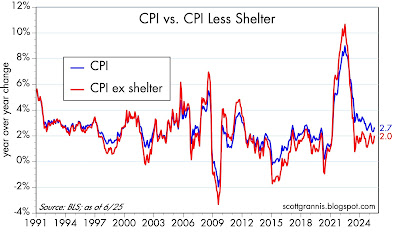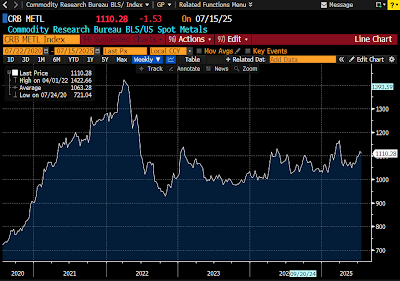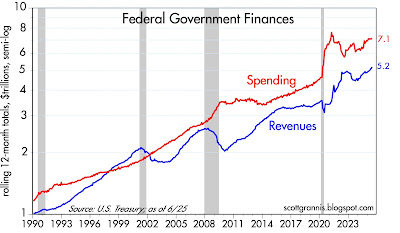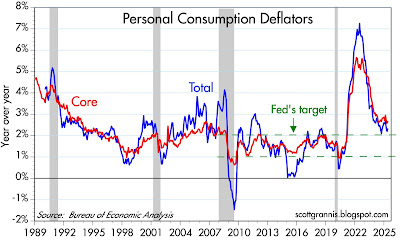This post is an update of a thesis I have been working on for many years. It's based on a fundamental tenet of Milton Friedman, who taught us that inflation happens when there is an oversupply of money relative to the demand for it. Newer readers might want to read my description of how I learned to understand this while living in Argentina, and how this helped me predict the big jump in US inflation in the 2021-22 period.
For the past two years money demand has stabilized as M2 growth has picked up moderately. The "bulge" in M2 money supply has been almost completely absorbed by economic growth, with the result that there is no longer a monetary source of inflation that the Fed needs to stop—higher interest rates are not necessary. M2 money supply is once again growing at a 5-6% rate, which is similar to what we saw in the period from 1995 through Q1/20—a period when CPI inflation averaged about 2%. Given
Chart #1
Chart #1 shows the level of the M2 money supply, which grew at a fairly steady rate of about 6% per year from 1995 to just prior to the Covid panic. M2 subsequently exploded as the government "printed" some $6 trillion to pay for an avalanche of Covid-related checks to the population. The Fed began to reverse this process in mid-2022, by raising interest rates and slowing the growth of M2, which has grown by only $500 billion since its 2022 peak. M2 today is only about $1.4 trillion above where it would have been if the 1995-2020 trend growth had continued.
Chart #2
Chart #2 is my way of measuring money demand: M2 divided by nominal GDP. The ratio is a proxy for the amount of readily spendable cash that people want to hold as a percentage of their annual income. For many years (50s, 60s, 70s, and 80s) money demand was fairly stable. That is what led Milton Friedman to assume that the velocity of money in his famous equation (M*V=P*Y) was relatively constant. But as we have learned in recent decades, that is a highly questionable assumption. In my way of looking at things, the demand for money should be the focus (money demand is the inverse of money velocity), since it ties in with the theory that the price level changes when the demand for money exceeds the supply of it.
Sharply rising money demand in the wake of Covid effectively offset the sharp increase in money supply, as evidenced by the fact that inflation didn't pick up until 2021, when money demand started to plunge but money supply remained relatively constant.
Today, Chart #2 tells us that money demand has ceased falling and is picking up just a bit. Combined with the fact that money supply is growing at a "normal" rate, we should expect to see inflation decline modestly, which in fact it has if we exclude shelter costs.
Chart #3
Chart #3 makes a very important point: the growth of private sector jobs has decelerated significantly in recent years. However, the growth rates shown are most likely overstating the true growth rate, given the relatively large downward adjustments the BLS has made after the fact, and especially considering the magnitude of deportations in recent months. True jobs growth might well be only slightly more than half the rates shown in the chart. That amounts to a significant headwind to economic growth, and it has also contributed to depress confidence (most of measures of which are at relatively low levels). Any loss of confidence is likely to increase the public's demand for safety—and money hoarding is a natural response to that. Weak economic growth is likely fueling at least a modest increase in the demand for money. The Fed should respond to this by relaxing policy. And they have, reducing the federal funds rate by a quarter point recently. More cuts are likely in order and I hope they follow soon.






















































